|
© 2001-2004 C&StL |
Faire de l'opérationDans les trains miniatures, il ya deux tendances: ceux qui essaient de représenter le plus fidèlement possible une pièce de matériel roulant en miniature. Ce sont les "modélistes". Et il y a ceux qui essaient de représenter le comportement des trains le plus fidèlement possible. Ce sont les "opérateurs". Les modélistes vont investir beaucoup sur une locomotive pour lui ajouter des détails, comme les pare-soleils et le boyeaux d'air, par exemple. Que cette locomotive très détaillée ne tire qu'un ou deux wagons derrière, n'a pas une grande importance pour eux. Les opérateurs eux sont à l'inverse. Les détails de la locomotive sont plus ou moins important pour vue que ce soit une représentation assez fidèle. Mais une locomotive qui ne tire que trois wagons est inacceptable, car aucun chemin de fer réel ne fait ça, ce n'est pas rentable. Rien n'est jamais blanc ou noir. La plupart des gens tombent entre ces deux extrêmes. Faire de l'opération consite donc à modeler le façon d'opérer des vrais chemins de fer. Comme je vais vous le démontrer dans les exemples suivants, on peut faire de l'opération simplement avec un circuit oval et une voie d'évitement. À l'autre extrémité du spectre, on peut faire de l'opération avec un immense réseau, et où un ordinateur produit des listes de wagons à aller porter à des heures précises à des endroits précis. Des logiciels très sophistiqués existent pour faire cette tâche. ShipIt!, de Albion Software en est un exemple. Ce que plusieurs personnes trouvent d'intéressant dans l'opération, c'est qu'il y a un grand défi pour l'esprit. Car avant de faire le premier mouvement, il faut penser. Comme les échecs, il faut penser plusieurs coups d'avance. Une locomotive, ça ne pivote pas sur elle-même comme peut le faire une auto et ça ne saute pas par-dessus les wagons. Nous sommes donc limité dans les possibilités de mouvement. L'opération est aussi une façon de
rendre le hobby beaucoup plus intéressant. La plus détaillée
des locomotives qui tourne en rond sur une piste deviendra vite ennuyante... Opération de base
Exemple #1
Exemple #2Dans l'exemple #1, il y avait une certaine facilité du fait que le train était déjà dans une direction favorable versus la position de l'embranchement. On peut compliquer cet exemple en faisant simplement tourner le train en sens inverse.
Les deux exemples ci-haut demeurent relativement simple. Sur les vrais chemin de fer, on utilise plusieurs locomotives pour tirer un train. Parmis les locomotives, on en met souvent une ou deux en sens inverse de la marche. Cette façon de faire a pour but d'avoir toujours une locomotive "de face" lorsqu'on fait de l'opération... Et les équipes n'ont pas à tourner les locomotives aux terminaux! En modificant légèrement le plan des voies des exemples ci-haut, on peut compliquer énorment les opérations de manoeuvre.
Remarque: Les chemins de fer réels utilisent une méthode appellée "méthode par lancement". Dans l'exemple #2, on pourrait utiliser cette méthode. Il s'agit de détacher le wagon mauve sur le voie principale pendant que le train roule à une vitesse de 10 mi/h. La locomotive et le train passe sur l'aiguillage et accélère sur la voie principale. Une fois le train passé et AVANT que le wagon mauve arrive à la hauteur de l'aiguillage, un préposé tourne les aiguilles pour l'embranchement. Le wagon mauve entre alors dans l'embranchement et un autre préposé qui est sur le wagon arrête celui-ci avec le frein du wagon. Cette méthode est non seulement dangereuse mais aussi risquée. La marge d'erreur est inexistante. Si le wagon va trop vite, on risque de ne pas être capable de l'arrêter avant la fin de la voie. S'il va trop lentement, il risque de s'immobiliser sur l'aiguillage. Dans ce cas, il bloquerait l'embranchement ET la voie principale... Problème difficile à résoudre! Dû aux contraites physique des modèles réduits, cette méthode est impossible avec les trains miniatures. En revanche, dites-vous que les vrais trains disposent rarement d'un circuit en boucle, comme un oval, pour faire le tour de leur train! Avant de copier cette page, lisez le copyright
|
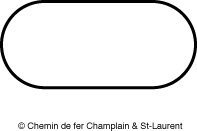 |
Here is an oval. A train just going around it will become borring very soon. |
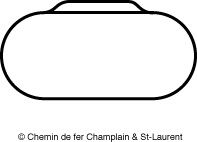 |
Lets add a siding. Operation can now begins. Even two trains can run the same oval. They can run in opposite direction and meet at the siding. This begins to look like operation! |
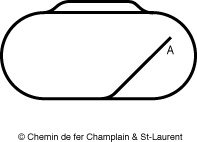 |
And now, add a spur. At the end of the spur, place a coal mine (letter A). Take a look at two examples of operation we can do with this simple track arrangement. |
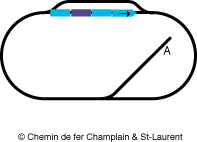 |
The locomotive is represented by the blue rectangle with the sharp end indicating the nose of the loco. The black arrow indicate the direction of movement. In this example, we will spot the purple car at "A". |
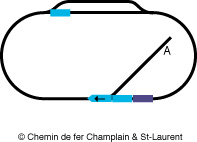 |
The first move is the uncouple the last car of the train on the main track. The rest train continu toward the spur. |
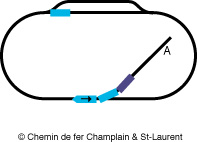 |
When the trains has passed the switch, it will stop. The switch will be lined to let the train enter the spur. The train can now back up in the spur. |
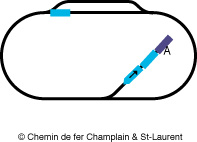 |
The purple car will be spotted in front the coal mine ("A"). He can be uncouple from the train. |
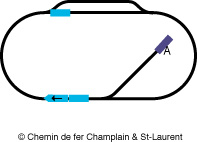 |
The direction of the loco can be reversed. The train can be pulled on the main track. When the car behind the loco has passed the switch, the switch can be lined back for the main line. |
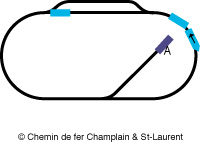 |
The train can be backed up to couple the car left on the main line. |
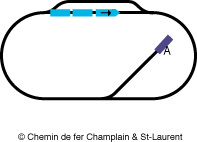 |
The train can now go forward for some tour. During this time, you can think of your moves to put back the purple car in his place on the train! |
Example #1 is not hard because the train is already going in the good direction for the spur. Lets complicated this example simply by reversing the direction of the train.
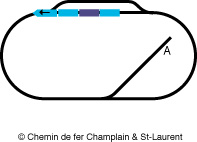 |
In the example, we will have more move to do, because the train is now facing the spur. If the locomotive enter directly in the spur, she will be stuck between then end of track and her train. |
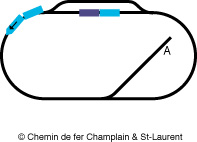 |
Lets start by uncouple the purple car (which is supposed to go to depot "A") and the car behind it on the main track. |
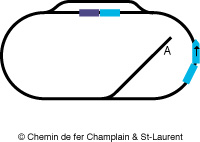 |
The locomotive and the last car made a complete tour around the layout to catch from behind the last two cars left on the main track. We can also use the siding to "run around" the last two cars. |
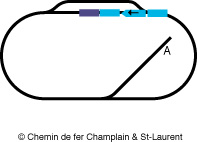 |
The locomotive can now push the purple car to its destination. |
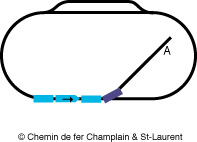 |
The switch must be lined for the spur. The train enter the spur... |
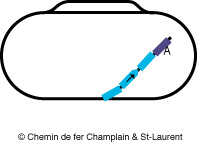 |
... and push the purple car to his location in front of the coal mine at "A". |
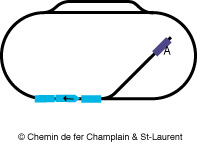 |
When the car is uncoupled, the train can be run backward to go out from the spur. But we have a little problem: the locomotive is stuck between the two cars of her train. |
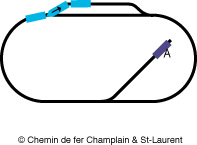 |
We need to place the car in front of her at the rear of the train. Lets use the siding. |
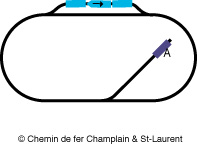 |
When the car is in the siding, uncouple it from the locomotive. |
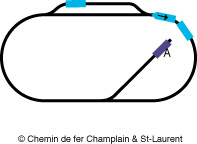 |
The locomotive can continu backward to the main track. |
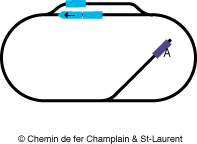 |
The locomotive will now run forward to "run around" the car in the siding. |
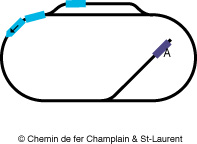 |
And when the switch of the siding is cleared... |
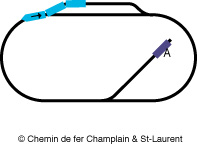 |
... the train can back up to couple the car. Second option: the last move could has been done simply by uncoupling the car in front of the locomotive on the main track, and continu backward until the train couple the car. |
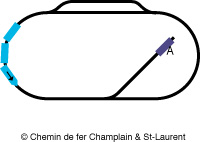 |
The train can now continu its journey... |
Both example above are relatively easy. On a real railway, they often use more than one locomotive to pull a train. They put one or two in reverse. This help sometime to have at least one locomotive facing forward when doing switching move. And the crew doesn't have to turn locos at terminal...
By adding some track to the above track plan, switching can be complicated a lot!
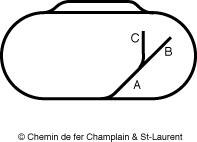 |
If, as an example, we add a spur to the already existing spur and we add two more depots (B and C)... |
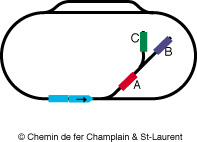 |
...How can you couple the green car to the rear of your train (which is facing the spur?). Have fun! |
Note: Real railroads also use another method. This method uses inertia force. This method could be use in example #2. Here how it's work: The car being placed on the spur is uncouple from the train when the train is running at 10 mi/h toward the spur. The switch is lined for the main train. As soon as the car is uncoupled, the loco begind to accelerate. When the locomotive has passed over the switch, the switch is being thrown and the car (running alone) will take the spur. A brakeman on the car will stop it at the proper location, with the help of the brake on the car.
The method is very dangerous and very risky. There is no place for error. If the car is running too fast, the brakeman may be not able to stop it befor the end of track or other cars. if the car is going too slow, it may stop over the switch, blocking the spur and the main line in the same time... A difficult problem to solve!
Obviously, the method can not be applied to miniature train. But don't worry, be happy: real train can not run in circle on an oval to run around their cars!!